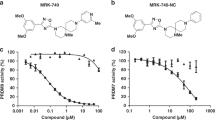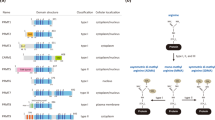Abstract
We have analysed the importance of proper substrate methylation by S-adenosylmethionine-dependent methyltransferases for cell survival and cell cycle progression. We show that treatment of cells with the methyltransferase inhibitor adenosine dialdehyde (AdOx) causes cell cycle arrest and death in different cell types. The phenotypical outcome and form of cell death was strikingly dependent on the AdOx concentration. Lower AdOx concentrations led to a G2 arrest and predominantly caused apoptosis, as judged by biochemical and morphological criteria. Apoptotic cell death was largely dependent on the presence of the tumour suppressor p53, but did not require the Bcl-2 family member Bax. Interestingly, higher concentrations of AdOx led to a novel and so far undescribed form of cell death, which was characterized by distinct, caspase-independent alterations of the cell shape including a marked protuberation of the nucleus, cytoplasmic extensions, actin aggregation, and incomplete chromatin condensation. Although this latter form of cell death was clearly distinguishable from apoptosis, early apoptotic features such as Bax activation were detected, indicating a commitment but incomplete execution of apoptosis. Altogether, these data show that methylation reactions play a distinct role in cell survival, which might influence the decision between different phenotypic forms of cell death.
This is a preview of subscription content, access via your institution
Access options
Subscribe to this journal
Receive 50 print issues and online access
$259.00 per year
only $5.18 per issue
Buy this article
- Purchase on Springer Link
- Instant access to full article PDF
Prices may be subject to local taxes which are calculated during checkout





Similar content being viewed by others
References
Bartel RL and Borchardt RT . (1984). Mol. Pharmacol., 25, 418–424.
Bergmann S, Shatrov V, Ratter F, Schiemann S, Schulze-Osthoff K and Lehmann V . (1994). J. Immunol., 153, 1736–1743.
Bunz F, Dutriaux A, Lengauer C, Waldman T, Zhou S, Brown JP, Sedivy JM, Kinzler KW and Vogelstein B . (1998). Science, 282, 1497–1501.
Bursch W, Hochegger K, Torok L, Marian B, Ellinger A and Hermann RS . (2000). J. Cell Sci., 113, 1189–1198.
Chen T and Li E . (2004). Curr. Top. Dev. Biol., 60, 55–89.
Chipuk JE and Green DR . (2005). Nat. Rev. Mol. Cell Biol., 6, 268–275.
Chuikov S, Kurash JK, Wilson JR, Xiao B, Justin N, Ivanov GS, McKinney K, Tempst P, Prives C, Gamblin SJ, Barlev NA and Reinberg D . (2004). Nature, 432, 353–360.
Clarke S and Banfield K . (2001). Homocysteine in Health and Disease. In: Carmel R and Jacobsen D (eds). Cambridge University Press: Cambridge, England, pp. 63–78.
Clarke S and Banfield K . (2002). Chemistry and Biology of Pteridines and Folates. In: Milstein S, Kapatos G, Levine RA and Shane B (eds). Kluwer Academic Publishers: Boston, pp. 557–562.
Coleman ML, Sahai EA, Yeo M, Bosch M, Dewar A and Olson MF . (2001). Nat. Cell Biol., 3, 339–345.
Croft DR, Coleman ML, Li S, Robertson D, Sullivan T, Stewart CL and Olson MF . (2005). J. Cell Biol., 168, 245–255.
Cuervo AM . (2004). Mol. Cell Biochem., 263, 55–72.
Di Simone N, Maggiano N, Caliandro D, Riccardi P, Evangelista A, Carducci B and Caruso A . (2003). Biol. Reprod., 69, 1129–1134.
Finkelstein JD . (1998). Eur. J. Pediatr., 157 (Suppl 2), S40–S44.
Grzanka A, Grzanka D and Orlikowska M . (2003). Biochem. Pharmacol., 66, 1611–1617.
Hennessey ES, Drummond DR and Sparrow JC . (1993). Biochem. J., 291, 657–671.
Jackson-Grusby L, Beard C, Possemato R, Tudor M, Fambrough D, Csankovszki G, Dausman J, Lee P, Wilson C, Lander E and Jaenisch R . (2001). Nat. Genet., 27, 31–39.
Jamison JM, Gilloteaux J, Taper HS, Calderon PB and Summers JL . (2002). Biochem. Pharmacol., 63, 1773–1783.
Karpf AR, Moore BC, Ririe TO and Jones DA . (2001). Mol. Pharmacol., 59, 751–757.
Kruman II, Culmsee C, Chan SL, Kruman Y, Guo Z, Penix L and Mattson MP . (2000). J. Neurosci., 20, 6920–6926.
Kruman II, Wersto RP, Cardozo-Pelaez F, Smilenov L, Chan SL, Chrest FJ, Emokpae Jr R, Gorospe M and Mattson MP . (2004). Neuron, 41, 549–561.
Leist M and Jaattela M . (2001). Nat. Rev. Mol. Cell Biol., 2, 589–598.
Martin SS and Leder P . (2001). Mol. Cell. Biol., 21, 6529–6536.
Mehlhorn H, Mencke N and Hansen O . (1999). Parasitol. Res., 85, 625–637.
Nicoletti I, Migliorati G, Pagliacci MC, Grignani F and Riccardi C . (1991). J. Immunol. Methods, 139, 271–279.
Proskuryakov SY, Konoplyannikov AG and Gabai VL . (2003). Exp. Cell Res., 283, 1–16.
Rao JY, Jin YS, Zheng Q, Cheng J, Tai J and Hemstreet III GP . (1999). J. Cell Biochem., 75, 686–697.
Ratter F, Gassner C, Shatrov V and Lehmann V . (1999). Int. Immunol., 11, 519–527.
Rice JC, Briggs SD, Ueberheide B, Barber CM, Shabanowitz J, Hunt DF, Shinkai Y and Allis CD . (2003). Mol. Cell, 12, 1591–1598.
Schneider-Stock R, Diab-Asseff M, Rohrbeck A, Foltzer-Jourdainne C, Boltze C, Hartig R, Schonfeld P, Roessner A and Gali-Muhtasib H . (2004). J. Pharmacol. Exp. Ther., 312, 525–536.
Schubert HL, Blumenthal RM and Cheng X . (2003). Trends Biochem. Sci., 28, 329–335.
Schwerk C, Prasad J, Degenhardt K, Erdjument-Bromage H, White E, Tempst P, Kidd VJ, Manley JL, Lahti JM and Reinberg D . (2003). Mol. Cell. Biol., 23, 2981–2990.
Sebbagh M, Renvoize C, Hamelin J, Riche N, Bertoglio J and Breard J . (2001). Nat. Cell Biol., 3, 346–352.
Sgarra R, Diana F, Rustighi A, Manfioletti G and Giancotti V . (2003). Cell Death Differ., 10, 386–389.
Shintani T and Klionsky DJ . (2004). Science, 306, 990–995.
Song Z, Zhou Z, Uriarte S, Wang L, Kang YJ, Chen T, Barve S and McClain CJ . (2004). Hepatology, 40, 989–997.
Sperandio S, de Belle I and Bredesen DE . (2000). Proc. Natl. Acad. Sci. USA, 97, 14376–14381.
Stancheva I, Hensey C and Meehan RR . (2001). EMBO J., 20, 1963–1973.
Suarez-Huerta N, Mosselmans R, Dumont JE and Robaye B . (2000). J. Cell Physiol., 184, 239–245.
White SR, Williams P, Wojcik KR, Sun S, Hiemstra PS, Rabe KF and Dorscheid DR . (2001). Am. J. Respir. Cell Mol. Biol., 24, 282–294.
Wyllie AH and Golstein P . (2001). Proc. Natl. Acad. Sci. USA, 98, 11–13.
Zhang L, Yu J, Park BH, Kinzler KW and Vogelstein B . (2000). Science, 290, 989–992.
Zhang Y and Reinberg D . (2001). Genes Dev., 15, 2343–2360.
Zong WX, Ditsworth D, Bauer DE, Wang ZQ and Thompson CB . (2004). Genes Dev., 18, 1272–1282.
Acknowledgements
We thank Dr H Mehlhorn and M Nissen for help with electron microscopy, and Drs W Wetzel, F Essmann and members of the Häussinger lab for help with confocal microscopy. This study was supported by grants from the Deutsche Krebshilfe and the Deutsche Forschungsgemeinschaft (SFB 503).
Author information
Authors and Affiliations
Corresponding author
Rights and permissions
About this article
Cite this article
Schwerk, C., Schulze-Osthoff, K. Methyltransferase inhibition induces p53-dependent apoptosis and a novel form of cell death. Oncogene 24, 7002–7011 (2005). https://doi.org/10.1038/sj.onc.1208855
Received:
Revised:
Accepted:
Published:
Issue Date:
DOI: https://doi.org/10.1038/sj.onc.1208855
Keywords
This article is cited by
-
Protein arginine methylation: an emerging regulator of the cell cycle
Cell Division (2018)
-
Differential effects of AdOx on gene expression in P19 embryonal carcinoma cells
BMC Neuroscience (2012)
-
Deacetylation and Methylation at Histone H3 Lysine 9 (H3K9) Coordinate Chromosome Condensation during Cell Cycle Progression
Molecules and Cells (2011)
-
Rapid transcriptional response of apple to fire blight disease revealed by cDNA suppression subtractive hybridization analysis
Tree Genetics & Genomes (2009)
-
Double-edged swords as cancer therapeutics: simultaneously targeting p53 and NF-κB pathways
Nature Reviews Drug Discovery (2008)



